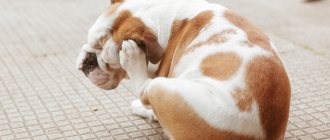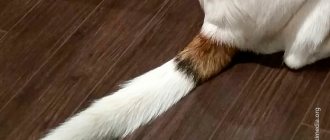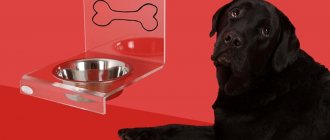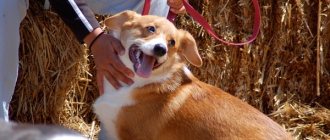How often can you hear complaints from dog owners about the unpleasant odor left by the liquid that the pet sprayed from the anal glands. But this is not the only trouble associated with this body. Sometimes the dog suddenly bleeds from that very rear place, and it furiously licks “under its tail,” and it can also “scratch its butt,” and ride it unsightly on the floor or ground. What is happening to our pets? Is all this normal, or do these signs indicate health problems?
In almost all cases, except for marking territory, any manifestation of a dog’s interest in its own glands can be considered a deviation from the norm. As soon as they begin to disturb the animal, you need to immediately examine it and take action.
Functions of anal glands in dogs
The anal glands (sines), through which dogs and cats release their scent, are located under the skin near the anus, their ducts open directly into the anus. To find out the exact location of the organ, take a watch: the glands are located around the anus where the hands will be at 20:00 and 4:00. They are a symbiosis of sweat and sebaceous ducts.
The anal glands secrete a hormonal odorant that has a unique odor for each animal of the same species. Therefore, we can say that every dog smells differently. It is for the purpose of remembering and comparing the scent that dogs and cats, upon seeing a “colleague,” immediately begin to sniff the anal area. This is how they get to know and study their new friend.
The structure of the anal glands in dogs
Inflammation of the anal glands
Author: Eremina Ekaterina Stanislavovna (translation from German)
Sometimes you can notice how the dog “rides” along the floor with characteristic movements in a sitting position. Often the dog simultaneously tries to reach the anal area with its teeth or lick it. This phenomenon can have harmless causes, but it can also indicate a serious problem related to the anal glands.
WHAT IS ANAL GLAND INFLAMMATION?
On the left and right, just below the anus, each dog has anal sacs. These are two small cavities in which the secretion of the anal glands accumulates. The size of the cavity varies depending on the size of the dog and can range from 0.25 to 7.5 ml. The secretion of the gland passes through narrow ducts, which in all dogs, regardless of body size, have a diameter of one to two millimeters and a length of three to five millimeters. A small amount of this secretion is released mainly during the act of defecation. It is needed to uniquely mark its territory and has an individual scent for each dog. In a frightened animal, the entire secretion is often released at one time. Inflammation may begin in the area of the anal sacs due to thickening of stool and impaired evacuation. The ducts often become clogged. In addition to this, bacterial infection can occur, which consequently leads to inflammation of the anal sacs and glands, the so-called peri-anal sinusitis.
CAUSES OF INFLAMMATION.
Inflamed and clogged anal glands are not uncommon in dogs. The reasons can be very diverse.
PREDISPOSITION OF CERTAIN BREEDS AND METABOLIC DISORDERS.
Some breeds have a genetic predisposition to inflammation of the anal glands, namely small breed dogs and dogs with short docked tails. Even long-haired breeds in which the area around the anus is not clipped require special attention. Other reasons include allergic processes, due to which glandular secretions can harden. Various metabolic disorders, diabetes mellitus, lipid metabolism disorders, thyroid dysfunction and liver diseases do not affect the functioning of the anal glands for the better. The possibility of penetration of various bacteria is facilitated, since the animal’s natural defenses are weakened by metabolic disorders.
SYMPTOMS OF INFLAMMATION.
The anal glands filled with secretions are exposed to bacteria, which causes inflammation. The dog experiences itching and pressure in the anus, tries to bite or lick the disturbing area, spins in place and “rides” along the floor. Dogs, unlike cats, have difficulty reaching the anus with their teeth, so they can bite the adjacent areas until they bleed.
FORMATION OF ABSCESSES AND FISTULAS.
The further course of the disease leads to the formation of visible pustules, abscesses and extensive eczema of the anus. In addition, invisible and deeper fistulas are not visible to a layman. Fistulas are neoplasms of the ducts, which are a new place for secretion to exit. You may encounter a fistula filled with purulent discharge. As a result, the dog may have a high temperature, fever, and pain throughout the affected area if treatment is not developed. For owners, the disease manifests itself in the fact that the dog cannot sit, whines and tries to avoid defecation. Inflammation of the anal glands can become chronic, in which the disease will recur again and again.
TREATMENT.
If inflammation is suspected, a trip to the veterinarian is not only recommended, but also necessary! The veterinarian will examine for the presence of secretions in the anal sacs and carefully clean them if the secretion is present and has a liquid consistency. If inflammation is confirmed, the abscesses are opened, cleaned and disinfected, and ointment is applied. Depending on the severity of the disease, antibiotics are prescribed. For chronic fistulas and abscesses, the only treatment is surgery with complete removal of the anal gland.
INDEPENDENT TREATMENT AND PREVENTION.
In dogs that are prone to inflammation, owners should perform a preventive examination and empty the anal sacs themselves. Healthy anal sacs are the size of a pea to a hazelnut. If they are significantly larger, they should be cleaned. To do this, the anus is compressed from the sides; for complete emptying, sometimes you need to insert one finger into the anus. Before you try to do the procedure yourself, you need to see how a veterinarian does it. When you self-medicate, you should always be very careful! Firstly, the secretion may thicken, and manual squeezing will only make the situation worse. Secondly, the secretion of the glands is a brown liquid that has an extremely unpleasant odor. If you feel that your dog is experiencing discomfort and pain from manipulation, it is better to refrain from self-treatment. This also applies when abscesses and fistulas already exist.
INDEPENDENT TREATMENT AND PREVENTION.
In dogs that are prone to inflammation, owners should perform a preventive examination and empty the anal sacs themselves. Healthy anal sacs are the size of a pea to a hazelnut. If they are significantly larger, they should be cleaned. To do this, the anus is compressed from the sides; for complete emptying, sometimes you need to insert one finger into the anus. Before you try to do the procedure yourself, you need to see how a veterinarian does it. When you self-medicate, you should always be very careful! Firstly, the secretion may thicken, and manual squeezing will only make the situation worse. Secondly, the secretion of the glands is a brown liquid that has an extremely unpleasant odor. If you feel that your dog is experiencing discomfort and pain from manipulation, it is better to refrain from self-treatment. This also applies when abscesses and fistulas already exist.
PREVENTION.
In long-haired dogs, the amount of undercoat and fur in the anal area can be reduced. In addition, you need to balance your diet so that the stool is not too hard or soft. Serious metabolic disorders need to be treated promptly in order to strengthen the body's natural defense mechanisms and improve overall condition.
Source: https://www.bellos-gesundheit.de/analdruesenentzuendung-beim-hund.html
Why does inflammation of the anal glands occur in dogs?
In the wild, dogs and cats constantly expel fluid from their anal glands to mark their territory, thereby warning other animals that the space has an owner. Marking from anal secretions is much stronger than marking from urine and does not easily rub off. As for domestic animals, many of them, due to domestication and selection, have lost the ability to voluntarily contract their anal muscles in order to spray secretions.
Obesity also plays a role. Approximately 60% of pets suffer from obesity due to the wrong attitude of their owners. The accumulation of fat around the muscles of the anal glands leads to a problem - the inability to “squeeze” the contents of the glands naturally. That's why dogs have to do all those licking, scratching, and butt-riding tricks. This is how they strive to get rid of the accumulated secretion.
If the fluid accumulates, the dog's anal glands become blocked, become inflamed, and even rupture may occur. It's quite painful. Plus, there is a threat of a secondary infection, with even more serious consequences. Sometimes surgery is required to remove the swelling, or, as a rule, the dog is prescribed long-term antibiotic therapy. On their own, without treatment, the inflamed glands cannot return to normal function.
Signs of inflammation of the anal glands
Inflammation of the anal gland in dogs
Determining that your pet has problems in “this place” is quite simple:
- the dog is worried;
- constantly licks under the tail, and even tries to gnaw out the fur;
- often turns back, trying to grab the tail with its teeth;
- moves his butt on the floor;
- anus red and swollen;
- When you press on the glands, you feel a dense tumor.
Don’t wait until your dog’s glands become inflamed. At the first sign, carry out a cleansing procedure.
Other reasons for anus licking
Along with blocked anal glands, there may be other trivial reasons why a dog is licking under its tail and whining.
- Worm infestation. Additional symptoms include: unpleasant odor from feces, secretion of mucus and blood, exhaustion of the animal against the background of normal nutrition, general lethargy. For treatment, it is necessary to take a course of antihelminthic drugs.
- Allergic reaction to plant nutrition and flowering. Accompanied by other symptoms: discharge from the nose and eyes, general skin itching.
- Neuralgic diseases, manifested in the repetition of a certain action, in particular licking the anus. This can lead to the development of acral dermatitis or furunculosis.
- Fungal infections. Pathogenic microflora enters the animal’s body during walks and causes changes in skin color and itching.
- Fleas that often live in the dog's crotch and near the tail.
- Bitches in heat, pregnancy or after giving birth. This, along with normal hygiene, may be associated with infections and inflammation of the genitourinary system.
In all of these cases, it is necessary to contact a veterinary clinic to examine the four-legged animal, clarify the diagnosis and prescribe treatment.
Thus, there are many reasons that provoke a dog to constantly lick the area under the tail. The most likely and common situation is a blocked anal gland. Identifying other causes requires a careful examination of the animal by a veterinarian.
Cleaning and treating anal glands in dogs
There is a common myth that diet affects the health of the anal gland. You've probably heard or read online that certain foods containing fiber can help improve and increase the volume of stool, which, thanks to your dog's pushing during bowel movements, will regularly empty the anal glands. In fact, there is absolutely no scientific evidence to support this theory. The anatomy around the anus is so complex, and the force of stool coming out of the anus is so low, that the idea of solving the problem of gland cleansing through foods containing fiber is a misconception.
Some pets don't need any help and can clean out their ducts themselves because their anal glands are well-pronounced. Other pets need cleaning weekly. Another category of dogs falls into the range where cleaning treatments are needed every few weeks or months. It is important to find a regular interval that suits your pet's needs.
Types and clinical symptoms
When examining the external genitalia, swelling and redness and skin rashes on the private lips are noticed. The bitch is lethargic, eats poorly, and develops intermittent fever, characterized by a rise in temperature in the evening and a drop to normal in the morning.
The infection enters the vagina from the outside - from the anus or hair surrounding the vulva, or from the urinary tract. Vaginitis is most dangerous during the period of pregnancy. Infection can lead to abortion, stillbirth, or non-viable babies.
There are the following types of vaginitis:
- Serous - characterized by the release of liquid or mucous translucent excreta, which, with the development of the inflammatory process, acquires a creamy tint.
- Catarrhal - characterized by a sour odor of cloudy white discharge.
- Purulent - viscous, yellowish with green, foul-smelling contents are separated.
- Fibrinous - films of precipitated fibrin protein settle on the walls of the vagina. The films should not be removed as this will cause ulcers to open. This form of the disease is characterized by copious discharge from the loop.
- Gangrenous - tissue death and fragmentation occurs. A foul-smelling ichor with pus and pieces of necrotic mucosa flows out.
As a type, juvenile vaginitis is isolated, which is recorded in teenage puppies. In most cases, the pathology goes away on its own after the first heat.
How to clean anal glands in dogs
Cleaning the anal glands should be done carefully!
Anal glands are also called anal sacs, and they are also called paraanal glands. The cleaning process itself is quite unpleasant, so many dog breeders turn to a veterinarian for this purpose. You can do it like this:
- Wear gloves and place the animal in a container where the liquid should drain. Ask an assistant to hold the pet, clasping it with your hands from the muzzle to the tail.
- Inspect the dog's rear, visually noting the pouches. After this, lift the tail up with one hand (not to the point of pain) - this will relieve tension from the perianal area, with the other, gently press on the swelling from the sides, bringing your fingers closer to the anus.
- The liquid is very disgusting in appearance and terribly smelling, it will flow out in a few seconds. It must be flushed down the drain immediately.
If the structure of the anal glands does not allow you to get rid of the secretion in such a simple way, then you will have to perform the operation in an even more unpleasant way.
- Lubricate your index finger with Vaseline or vegetable oil and insert it as gently as possible into the dog's anus. The finger should be held at a slight angle, pointing the phalanx towards the floor (as if from above).
- Feel for the gland, and grabbing it from the inside, help squeeze out the liquid with your thumb from the outside, moving your fingers towards the anus.
What to do if your dog has inflamed anal glands
The secretion contains many proteins and other elements that serve as an excellent substrate for the proliferation of bacteria. The more it accumulates, the more active and faster the inflammatory process will begin. If you notice signs of it, contact a specialist immediately. If it’s not too late, he will clean the anal sacs, process them, and then prescribe special suppositories (Proctosedyl, Ichthyol, etc.), which will have to be inserted into the dog’s butt.
It's done like this. Insert the candle and do not let it come out by pressing the anus with your fingers; after a minute the pet can be released. Small breeds do not require the entire dose of medication, so the candle must be inserted after cutting it.
If you miss the time, the bags may burst, and the purulent liquid will spread, finding a way out even through the skin. This process is called an abscess. With an abscess, a hole with erosive edges (similar to an ulcer) forms, through which a thick, purulent yellow substrate will ooze. The tissue around the fistula swells, and even large swelling is possible. The dog is worried and constantly tries to lick the wound. Here you cannot do without a veterinarian, since the glands still need to be cleaned, rinsed, and a drainage tube must be installed to drain the remaining pus.
It will take a long time to treat inflammation of the anal glands. You will also need to use anti-inflammatory suppositories, supplemented with antibiotic injections.
Reasons why your bitch licks her vulva
- Stressed dogs suffer terribly from the stress of our modern times. you can even control your owner's restless, nervous temperament or recording environment. For this reason, dogs are often stressed in large cities. Stress is actually an excessive accumulation of tension. To free itself from it, the body finds a drain valve. The bitch becomes accustomed to compulsive licking when she is restless or stressed. in this case, it is important to find out why the animal suffers from such stress, so that its health is not damaged.
- Hormonal Disorders Some dogs suffer from hormonal disorders and autoimmune diseases. these complaints may cause hyperactivity, stress or tension. That's why a bitch licks her vulva.
- Infections or Inflammations If the bitch licks herself frequently and the vulva is purulent, showing discharge, redness or swelling, then it is likely that she is being affected by an inflammatory or infectious process. In both cases, serious harm to the animal's health can occur. If your bitch is suffering from engorgement and is urinating more often than usual or in unusual places, this could be a sign of a urinary tract or bladder infection. If the vulva is swollen or red outside of the run, this may be a sign that the bitch is suffering from inflammation or allergies. A dirty or unsanitary environment can easily cause this. It is important to get the animal to the vet quickly. The microorganisms multiply quickly and can endanger much of your dog's body. especially when you get into the bloodstream. It is very important that you contact your veterinarian immediately if your bitch is suffering from these symptoms. How you can prevent infection from entering the uterus and ovaries and limit the reproduction process.
- masturbation Yes, dogs satisfy themselves. Both males and females need this. This is not malice or perversion. this is a natural habit during your sexual development. piece by piece, the puppies recognize themselves as individuals that are different from their mother. However, they do not yet know the difference between the sexes. Males and females behave the same and do not exhibit an active reproductive instinct.
Growth and maturity in dogs
Source: Facebook by AcousticTrench
When the first fluency occurs, the bitch expresses that she is now sexually active and ready to mate. Which Fluency is the most important moment of the beginning of reproductive life. The sexual development of an animal ensures the survival of the species.
This is why it often happens that bitches in the sixth or seventh month of life begin to lick the vulva for pleasure. this means that she discovers herself and matures to take part in a sexually active adult life.
Removal of anal glands
Problematic anal glands
In some cases, your veterinarian may suggest surgical removal of the anal glands. The operation is indicated if:
- the pet needs weekly cleaning, without which its anal glands become inflamed;
- he experiences constant relapses—chronic inflammation;
- he tolerates manual cleaning of the glands very poorly;
- Manual cleaning of the ducts does not produce results.
Removing anal glands from a dog is quite quick and simple. The specialist only needs to cut the skin twice, after which he pulls the bags out and cuts them off. After the operation, small stitches are applied, but they do not interfere and heal quickly.
In order for the healing process to proceed without incident, it is necessary to put the dog on a light diet and provide more frequent walks so that it does not have to restrain the urge to go to the toilet.
Prevention
As mentioned above, the enemy of dogs is obesity. This means that most of the preventive measures come down to combating this process. To ensure your dog remains healthy and never suffers from anal gland swelling, do the following:
- walk as often as possible, let your dog frolic, come up with physical exercises for it, for example, playing with a ball, “walking on its hind legs,” etc. ;
- The dog needs to be fed correctly, without overfeeding, without stuffing with nutritious food, and especially with sweets;
- regularly inspect your anal sacs;
- If the dog can’t cope on its own, clean them as needed.
Attention! If you notice a problem, do not self-medicate, take your dog to the veterinarian, as there are a number of pathologies with similar symptoms, but with a much worse prognosis for cure!











